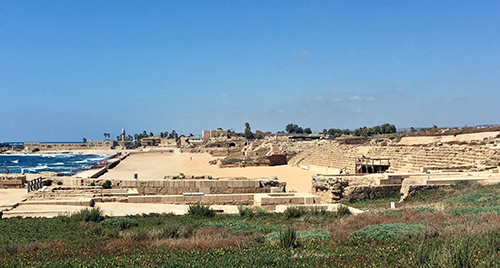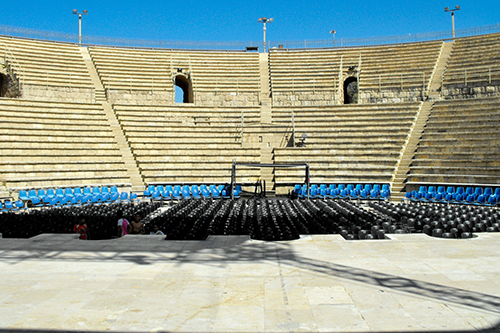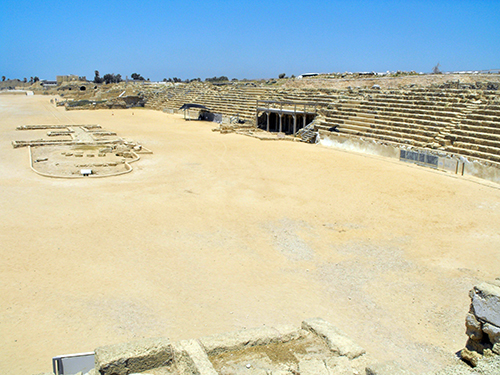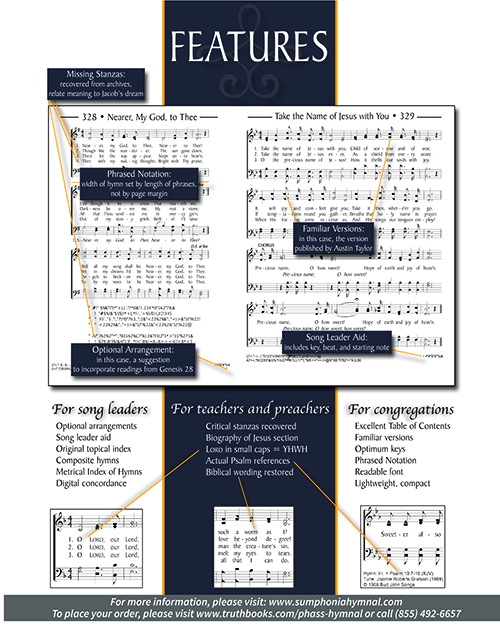

by Luke Chandler
Synopsis: Tourists to Caesarea are often told Herod Agrippa was stricken on the stage of the semi-circular theater, but history and archaeology provide good reasons to place this biblical event in the large oval arena adjacent to the palace.
Herod Agrippa, murderer of the apostle James, experienced a dramatic death in Acts 12. Luke tells us, "On an appointed day Herod [Agrippa] put on his royal robes, took his seat upon the throne, and delivered an oration… And the people were shouting, 'The voice of a god, and not of a man!' Immediately an angel of the Lord struck him down, because he did not give God the glory, and he was eaten by worms and breathed his last" (Acts 12:21-23, ESV).
The historian Josephus describes this same event with additional details. Herod Agrippa was stricken in the coastal city of Caesarea on the second day of a festival in Caesar's honor. It happened in the "theater" early in the morning when he showed up to view the day's events. He arrived wearing a silver garment that reflected the morning sun so brilliantly, it spurred the crowd to acclaim him as god-like. After accepting this divine praise, he was smitten with violent abdominal pain and died in agony five days later (The Antiquities of the Jews 19:343-351).
Tourists to Caesarea usually hear that Agrippa was stricken in the semi-circular theater along the coast, just south of the palace. This would seem to match the term "theater" used in Josephus' account. However, Josephus is inconsistent with his terminology for these kinds of buildings, and there are good reasons to conclude this story took place in the large oval arena on the other side of the palace, to the north of the theater.
The oval arena served as a hippodrome (chariot racing stadium) during the first century, but it was originally built as an amphitheater for various kinds of events. Josephus labels it an amphitheater in his description of the facility (Antiquities 15:341; The Wars of the Jews 21:415). It was 50 meters wide and 290 meters long, with twelve rows of seats to accommodate thousands of people. To provide spectators with a view of the sea, seats were not constructed on the coastal side of the amphitheater. This arena was immediately adjacent to the north side of the palace. The ruler could simply walk into his personal box without having to exit his residence and could address crowds or view events from his official seat. The semi-circular theater, on the other hand, was at least 50 meters separate from the palace and had a lower seating capacity. Events in the theater were limited by space to the stage and orchestra. The larger amphitheater was a better venue for the public spectacles taking place at the time of Agrippa's death.
An earlier incident involving Pontius Pilate supports the amphitheater as the location of Agrippa's story. Josephus records that when Pilate brought images of Caesar into Jerusalem, many Jews went to Caesarea and appealed for their removal at his official seat ("bema") in the "great stadium" (Wars 2.9.2-3). In the physical context of Caesarea, the "great stadium" best describes the amphitheater and Pilate's "bema" would have been his official box connected to the palace. A few years later, the official seat for Agrippa would likely have been in the same spot.
We must also note that Josephus places Agrippa's story in the early morning when the sun was relatively low in the eastern sky. If Agrippa was in the semi-circular theater, the many rows of seats on the eastern side (only the lower sections are preserved today) would have blocked the sun's rays from illuminating his silver garment until the late morning or after. On the other hand, the amphitheater's twelve rows of seats created a lower profile and would have permitted the sun to illuminate the silver garment as the morning's events were just beginning.
Archaeology provides another tool for understanding this story. A temple to Augustus Caesar stood above the harbor, plainly visible at the opposite end of the amphitheater from the ruler's seat. It was in sight of this pagan temple that the crowd acclaimed Herod Agrippa as divine. Whether God struck Agrippa next to a Roman temple as a message to the crowd, or as punishment for James' murder, we do not know. Many who witnessed a "god" suddenly double over in pain and die shortly after may have been led to reconsider their views of Roman religion and the God of the Jews.
Author Bio: Luke Chandler has worked with the North Terrace Church of Christ in the Tampa, Florida area for 12 years and has worked with archaeological expeditions in Israel for 9 years. He and his wife, Melanie, have five children. His website is lukechandler.wordpress.com. He can be reached at lukechandler@verizon.net.

Image 1: The long amphitheater with ruins of the adjacent palace in the foreground.

Image 2: The semi-circular theater showing the stage and current height of the seats. The seats went higher in the 1st century and would have blocked the early morning sun.

Image 3: A view of the amphitheater from near the ruler's official seat (Bema), where Agrippa was likely smitten.

